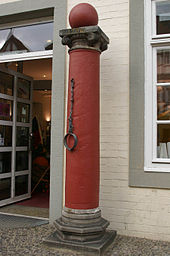Old Town Hall (Celle)
The old town hall is a listed building in the city of Celle in Lower Saxony and was the seat of the city administration until 1999.
The construction periods
The northern part of the town hall dates from the time the town was founded in 1292. Gothic vaults in this area of the town hall and in the Ratskeller indicate this.
The north gable in the Weser Renaissance style was built in 1579. The coats of arms of Duke Wilhelm the Younger and his wife Dorothea of Denmark above the entrance portal on the market come from the same time . The two figures on the two-story bay window probably show the emperor and his wife. A small portrait of the master builder Jacob Riess can be seen on the left entrance pillar.
Around 1580 three town houses were demolished and the town hall was expanded. First a half-timbered extension was built , which was renewed in 1785 in solid construction . In this extension there were halls on the ground floor and upstairs that served as market, court and festival rooms. For this part of the town hall, the name wedding house was used in the vernacular of Celle , because larger family celebrations of the citizens could also be held here.
The facade paintings
During restoration work in 1985, 13 layers of paint were discovered that had been applied over the centuries. Including lime, oil paint and artificial paint coatings in gray, yellow and yellow ocher. Outstanding was a layer of illusion painting from the 17th century, which is unique in Lower Saxony and was restored in the same year on the northern part of the town hall. After major damage occurred in 2002, the facade was renovated and restored from 2006 to 2009 at a cost of 1.98 million euros.
The inner
The leasing of the halls ended in 1858. They were then converted into work and office space. The hall on the ground floor served as a wine shop and restaurant and was used as the city treasury from 1921.
The artists Werner Hantelmann and Georg Herting redesigned the interior of the town hall in the 20th century: the inside of the town hall was renovated from 1938 to 1940 and was given its current appearance. In the newly created foyer on the first floor there are four baroque wooden figures that represent the virtues of temperance, justice, strength and wisdom and come from the Bornstedt Crown Estate .
After the New Town Hall opened in 1999 and various municipal offices moved out, the Old Town Hall was redesigned for new uses. Today the tourist information office, the administration of the castle theater and the Lower Saxony Academy for Homeopathy and Naturopathy are located here. There are also various rooms and halls available for receptions, meetings and weddings.
On June 8, 1378, the Ratskeller received the ducal right to serve wine and foreign beers, making it the oldest restaurant in Lower Saxony. The wall frescoes were made by the Berlin painter Walter Miehe (1883–1972) and date from the renovation phase from 1938 to 1940. During this time, the Ratskeller was given its current layout and design. In addition to the restaurant, the mayor's cellar , the rifle cellar and the councilor's cellar are available. All rooms offer 180 seats in total.
Elle and pillory pillars
The cubit at the entrance to the market is a replica from 1931 after the original cubit was stolen in 1855. The new cubit has a length of 62.5 cm, whereby the old cubit according to the ducal measure and weight order of 1692 was 58.4 cm long. On the cubit is the saying "An honest citizen here he measures what a Celler cubit really is."
The entrance to the tourist information office on the south gable is adorned by two pillory pillars with neck irons and the year 1786. They were two of four pillars of the former court arbor on the ground floor of the town hall. They were there until 1785. At first they were used as pillory, but were sold in 1863 and used as gate pillars. In 1908 they came into the possession of the Bomann Museum in Celle and were re-erected in front of the south gable in 1941.
literature
- Otto von Boehn : The Celle town hall - a guide through the building and cultural history . Ed .: Dieter-Jürgen Leister and Jürgen Ricklefs. Bomann Archive, Celle 1954, DNB 450531473 .
- Helmut Rüggeberg: History of the city of Celle in the context of the Lower Saxony state history . Bomann-Museum, Celle 2007, ISBN 978-3-925902-62-8 .
Web links
Individual evidence
- ^ Hugo Thielen : Hantelmann, Werner. In: Klaus Mlynek, Waldemar R. Röhrbein (eds.) U. a .: City Lexicon Hanover . From the beginning to the present. Schlütersche, Hannover 2009, ISBN 978-3-89993-662-9 , p. 269.
Coordinates: 52 ° 37 ′ 28.8 " N , 10 ° 4 ′ 52.5" E


